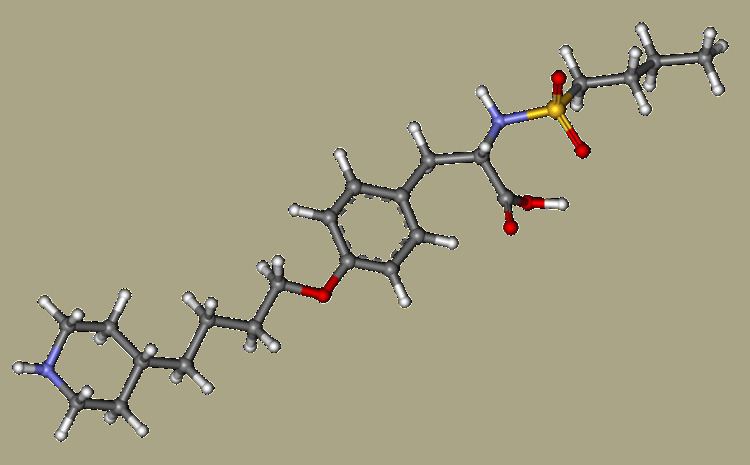Trade names Aggrastat MedlinePlus a601210 Molar mass 440.598 g/mol Protein binding 65% ATC code B01AC17 (WHO) Biological half-life 2 hours | AHFS/Drugs.com Monograph Bioavailability n/a (IV only) CAS ID 144494-65-5 Formula C22H36N2O5S Trade name Aggrastat | |
 | ||
Legal status In general: ℞ (Prescription only) | ||
Aggrastat tirofiban hydrochloride injection 100 ml 250 ml user guide
Tirofiban (INN, trade name Aggrastat) is an antiplatelet drug. It belongs to a class of antiplatelet named glycoprotein IIb/IIIa inhibitors. Tirofiban is the first drug candidate whose origins can be traced to a pharmacophore-based virtual screening lead.
Contents
- Aggrastat tirofiban hydrochloride injection 100 ml 250 ml user guide
- Tirofiban mecanismo de acci n
- Medical use
- Contraindications and precautions
- Cautions
- Adverse Reactions
- Use in pregnancy
- Pediatric use
- Other precautions and laboratory exams
- Side effects
- Interactions
- Pharmacology
- Chemistry
- History
- References
Tirofiban mecanismo de acci n
Medical use
Tirofiban is indicated to reduce the rate of thrombotic cardiovascular events (combined endpoint of death, myocardial infarction, or refractory ischemia/repeat cardiac procedure) in patients with non-ST elevation acute coronary syndrome (NSTE-ACS).
Contraindications and precautions
Tirofiban is contraindicated in patients with:
Cautions
Adverse Reactions
Bleeding is the most commonly reported adverse reaction.
Use in pregnancy
Tirofiban has been demonstrated to cross the placenta in pregnant rats and rabbits. Although the doses employed in these studies were a multiple of those used in human beings no adverse effects on the offspring in both animals have been seen. However, there are no adequate and well controlled studies in pregnant women. Therefore, tirofiban should be used during pregnancy only if clearly indicated.
Nursing mothers: It is not known whether tirofiban is excreted in human milk. However, significant levels of tirofiban are excreted in rat milk. Therefore, nursing should be discontinued during the period of drug administration and the milk discarded. Nursing may resume 24 hours after cessation of treatment with tirofiban.
Pediatric use
Safety and effectiveness in children have not been established.
Other precautions and laboratory exams
The activated partial thromboplastin time (aPTT) is .the most reliable coagulation parameter and should be obtained regularly during treatment, particular if a bleeding episode occurs that may be associated with tirofiban therapy. Other important hematological parameters are platelet count, clotting time, hematocrit and hemoglobin. Proper technique regarding artery site access for sheath placement and removal of sheath should be followed. Arterial sheaths should be removed when the patient's activated clotting time is < 180 sec. or 2 to 6 hours following. withdrawal of heparin.
Side effects
The following side effects were noted under treatment with tirofiban and heparin (and aspirin, if tolerated). Other drugs were used as necessary.
The major adverse effect is bleeding on local sites of clinical intervention and systemically (regarding parts of the body or the whole body system). Major bleeding has occurred in 1.4% of patients and minor bleeding in 10.5%. Transfusions were required to terminate bleeding and to improve bleeding-related anemia in 4.0% of all patients. Geriatric patients have experienced more bleeding episodes than younger, women more than men.
Thrombocytopenia was more often seen in the tirofiban + heparin group (1.5%) than in the heparin control group (0.8%). This adverse effect was usually readily reversible within days.
Positive fecal and urine hemoglobin tests have also been reported.
Post-marketing events have been the occurrence of intracranial bleeding, retroperitoneal bleeding, pulmonary hemorrhage and spinal-epidural hematoma. Fatal bleedings have been reported rarely.
Sometimes, thrombocytopenia was associated with chills, low-grade fever or bleeding complications (see above).
Cases of hypersenitivity including acute anaphylaxis have been seen.
Interactions
The concomitant application of warfarin or other oral anticoagulants may increase the risk of serious bleeding events. The decision whether maintenance therapy with these drugs should be discontinued during tirofiban treatment has to be made by the responsible clinician.
Pharmacology
Tirofiban has a rapid onset and short duration of action after proper IV administration. Coagulation parameters turn to normal 4 to 8 hours after the drug is withdrawn.
Chemistry
Tirofiban is a synthetic, non-peptide inhibitor acting at glycoprotein (GP) IIb/IIIa receptors in human platelets. It therefore constitutes an antithrombotic, specifically an inhibitor of platelet aggregation.
It is a modified version of a molecule found in the venom of the saw-scaled viper Echis carinatus.
History
The drug is marketed under the brand name AGGRASTAT in the US by Medicure Pharma, in China by Eddingpharm, and in the rest of the world by Correvio International Sàrl.
According to the US Orange Book, it was first approved in the US on 20 April 2000. Patent numbers 5733919; 5965581 and 5972967 all expire in October 2016. Patent 5978698 expires in October 2017. Patent 6136794 expires in January 2019. Patent 6770660 expires in June 2023.
